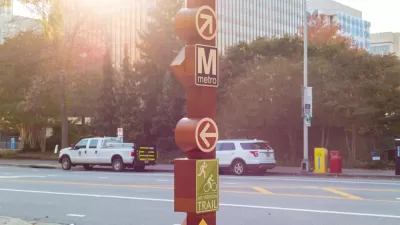When it comes to intersections, adding more complexity can do more harm than good, according to a recent, detailed post on Greater Greater Washington.
Ben Ross decries the growing complexity of traffic signals at intersections all over the country, which might be better at distracting drivers than they are at directing them.
Ross selects the "intersection of doom" in Arlington—where Mount Vernon Trail turns into Custis Trail at the foot of the Key Bridge in Arlington—as a case study of unnecessary complexity in traffic signals and intersection design. There, explains Ross, "Drivers must simultaneously watch for cars coming from the left, cyclists and pedestrians entering the crosswalk from the right, and an overhead signal that went in in January that flashes a no-right-turn graphic for a few seconds during the leading pedestrian interval." Moreover, "the no-right-turn graphic is hard to see in bright light, and it is flanked by highly visible signs that seem to say turns are allowed."
According to Ross the arrangement of this intersection is common around American cities—the only thing remarkable about it is the large number of bikes and pedestrians travelling through the intersection.
The article goes on to discuss larger concepts that inform an understanding of how intersections like this fail to meet a goal of reliably keeping roads safe. Ross notes especially that two concepts are missing from traffic engineering guidelines: redundancy and parsimony. "Redundancy means backups for missed signals and improper actions. Parsimony means signals aren't excessively complex."
FULL STORY: Complex traffic signals make streets less safe

Alabama: Trump Terminates Settlements for Black Communities Harmed By Raw Sewage
Trump deemed the landmark civil rights agreement “illegal DEI and environmental justice policy.”

Planetizen Federal Action Tracker
A weekly monitor of how Trump’s orders and actions are impacting planners and planning in America.

The 120 Year Old Tiny Home Villages That Sheltered San Francisco’s Earthquake Refugees
More than a century ago, San Francisco mobilized to house thousands of residents displaced by the 1906 earthquake. Could their strategy offer a model for the present?

In Both Crashes and Crime, Public Transportation is Far Safer than Driving
Contrary to popular assumptions, public transportation has far lower crash and crime rates than automobile travel. For safer communities, improve and encourage transit travel.

Report: Zoning Reforms Should Complement Nashville’s Ambitious Transit Plan
Without reform, restrictive zoning codes will limit the impact of the city’s planned transit expansion and could exclude some of the residents who depend on transit the most.

Judge Orders Release of Frozen IRA, IIJA Funding
The decision is a victory for environmental groups who charged that freezing funds for critical infrastructure and disaster response programs caused “real and irreparable harm” to communities.
Urban Design for Planners 1: Software Tools
This six-course series explores essential urban design concepts using open source software and equips planners with the tools they need to participate fully in the urban design process.
Planning for Universal Design
Learn the tools for implementing Universal Design in planning regulations.
Clanton & Associates, Inc.
Jessamine County Fiscal Court
Institute for Housing and Urban Development Studies (IHS)
City of Grandview
Harvard GSD Executive Education
Toledo-Lucas County Plan Commissions
Salt Lake City
NYU Wagner Graduate School of Public Service





























